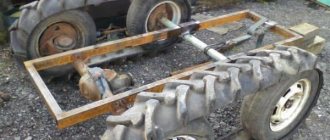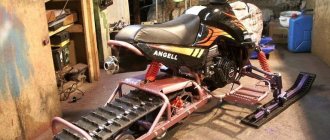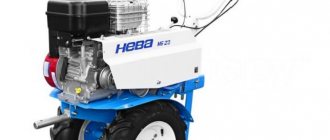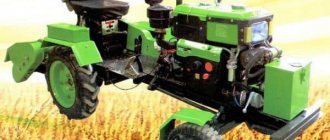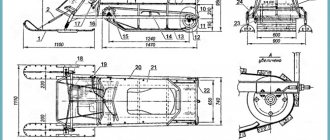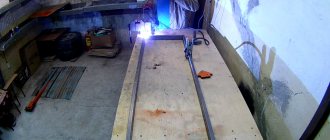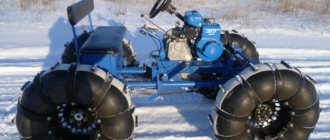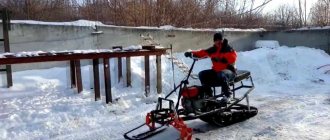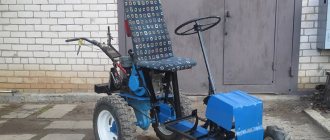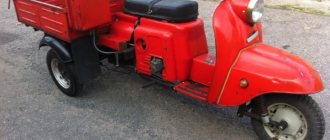Owners of walk-behind tractors are increasingly resorting to all sorts of home-made production of various components for this unit.
As a result, we get do-it-yourself attachments, transforming the walk-behind tractor into a more powerful one by installing a new engine, as well as many different modifications and additions.
Of course, all this is not due to a good life, because most owners of a walk-behind tractor strive not only to save on its purchase, but also to reduce the costs of its further operation.
In particular, many want to make homemade tracks for walk-behind tractors, thereby wanting to improve the cross-country ability of their units.
The resulting walk-behind tractor on tracks will perform a slightly different role in a person’s personal household, because it is already becoming a full-fledged vehicle, somewhat reminiscent of a caterpillar tractor.
Accordingly, a much wider scope of work opens up before him, which largely justifies this kind of independent alteration.
Crawler attachment device
The tracked attachment to the walk-behind tractor is used when carrying out various works in difficult operating conditions, in particular for:
- work in swampy and hard-to-reach areas;
- clearing the area of snow;
- transportation of goods in difficult terrain.
Also, a walk-behind tractor with tracks is often used simply as a vehicle in the winter.
According to the form of execution, tracked modules are divided into:
- Rectangular axial. In this design, the goosenecks are attached to the walk-behind tractor using bolts. At the bottom of the axle there are four rollers that provide tension to the track. There are two gears installed on both sides of the caterpillar, designed to provoke the movement of the walk-behind tractor. The movement of the entire installation occurs using a bushing-roller chain and an articulated drive.
- Triangular gears. This tracked module for a walk-behind tractor consists of large gears mounted on an axis connected to the gearbox, and 8 rollers located in pairs on the frame. They promote belt tension and ensure smooth movement of the walk-behind tractor. By raising and lowering the gear you can control how tight the track is.
Design features of the device
Making homemade caterpillar components for a walk-behind tractor with your own hands allows you to save money on the purchase of factory devices and further operation of the equipment. If everything is done correctly, then self-made tracks for a walk-behind tractor increase the cross-country ability.
Compared to their wheeled counterparts, tracked walk-behind tractors are not as widespread. This is explained simply. Wheel units from Texas, Patriot, Cayman, Viking, Forza are best suited for plowing land. This design is best suited for soil-related work.
Remaking a wheeled walk-behind tractor is a job consisting of attaching one additional wheel on each side. It turns out to be a four-wheeled walk-behind tractor on which you can put tracks. They can, in turn, be purchased or homemade. Additional wheels can be made removable. This allows you to promptly transform the unit into a standard walk-behind tractor, ideal for working in the garden.
https://youtube.com/watch?v=jaA5TZApcSU
To do this, the wheels are attached to the axle, which are already provided in the design, by means of a rigid or flexible transmission. This solution is considered appropriate, since the need for installing additional fasteners disappears. As for the design of these walk-behind tractors, they fully comply with the parameters of wheeled modifications:
- Engine. It is powerful, four-stroke. It has an axis locking function. Due to this, the tracked walk-behind tractor can turn in place without describing a full circle.
- Transmission. The standard set includes a gearbox, clutch system and gearbox.
- Chassis. Caterpillars are used here. They replace the wheelbase. If a modification is made, then one roll is added to the existing pair of wheels on each side. They put a homemade caterpillar on them.
- Control bodies. Located on the control handle. Includes emergency stop mechanisms and various types of clutch levers.
Before you start making your own, you need to evaluate the offers in stores that specialize in selling such equipment. Particular attention is paid to the price of certain types of tracks for well-known manufacturers of walk-behind tractors. Let’s say a caterpillar for a Neva walk-behind tractor costs about 28,000 rubles. This is a fully functional snowmobile attachment. You can buy a seat for drivers separately, thanks to which the walk-behind tractor takes on the features of a mini tracked tractor, albeit with less impressive performance characteristics. The technical parameters here are:
- develops a speed of about 18 km per hour;
- The total weight of the console is 37 kg;
- width - 60 cm;
- length - 100 cm;
- height - 34 cm.
Accommodates one driver and one passenger on board. In addition, on sale you can find an attachment to a walk-behind tractor on tracks, which is intended for the Salyut and Agat models. Its cost ranges from 25 to 27 thousand rubles. This design does not provide for attaching a driver's seat. Because of this, some restrictions are imposed on the functional features of this device. But for driving on off-road and snow, such a vehicle is quite suitable.
Their feature is the ability to control not only with two hands, walking behind a walk-behind tractor, but also while sitting in a folding sleigh. The latter will have to be purchased separately. Considering that the average cost of a set-top box is about 30 thousand rubles, not counting the price of folding sleds, we can say that making tracks yourself can save a lot of money.
Advantages of using tracks for walk-behind tractors
The caterpillar drive for a walk-behind tractor, compared to a wheel pair, has a larger supporting surface. This ensures:
- uniform distribution of the mass of the unit over the surface;
- better stability;
- high maneuverability of equipment;
- increased cross-country ability;
- all-weather use.
In the video below, you can see how the Neva MB 2 walk-behind tractor moves on caterpillar tracks.
A walk-behind tractor with a caterpillar attachment will not get stuck in a sticky or muddy surface. Experts say that the caterpillar drive seriously improves the cross-country ability of the vehicle. And this, in turn, allows you to diversify the range of tasks that the walk-behind tractor can handle.
In some situations, tracks are significantly superior to standard wheels.
The special requirements for the power plant of the cultivator should be taken into account. Air cooling is ineffective at extreme loads, which can lead to failure of the power plant. It is necessary to use a liquid-cooled motor, which has proven to be quite productive.
Adviсe
Before you start making homemade tracks, you need to correctly calculate all the parameters. It is necessary to take into account the height of the future caterpillar, otherwise exceeding it will shift the center of gravity and the walk-behind tractor will lose stability. In addition, the walk-behind tractor will lose such important controllability.
To solve this problem, it is necessary to slightly increase the second driven axis by a couple of centimeters. It would be a good idea to purchase a special extended bushing and install it, which will increase the width of the wheelbase and add stability.
It is also necessary to take care of the engine - water cooling should be installed. This is due to the fact that a simple air-cooled engine is not able to overcome heavy loads and will overheat. More stable performance indicators of the walk-behind tractor were found with a water-cooled motor installed.
Any improvement to the walk-behind tractor will increase its service life. For example, installing tracks will increase maneuverability. And water cooling will preserve the engine. The advantage of such upgrades is that all the necessary elements can be found in your garage.
Good luck in your endeavors!
Advantages and disadvantages of making homemade caterpillars
The positive aspects of this type of nozzles include:
- the ability to independently select good quality parts for manufacturing (a kind of control);
- since the equipment is made for oneself, they try to achieve maximum reliability and cross-country ability;
- cost (converting equipment to caterpillar tracks yourself is much cheaper than buying a factory unit).
There are no shortcomings as such. The only thing you will lose when making tracks for a walk-behind tractor with your own hands is time.
Necessary tools and materials for manufacturing
Before you move on to creating a tracked block for a walk-behind tractor, you should prepare the materials and tools required to assemble the product.
Materials:
- conveyor belt and bush-roller chain;
- tires from a truck or tractor;
- V-profile belts;
- chains;
- bolts, nuts and other fastening materials.
Depending on the selected type of crawler, something else may be needed or, conversely, it will be superfluous on this list.
Tools:
- angle grinder (grinder);
- drill;
- welding machine;
- hammer;
- various wrenches.
Having chosen one of the options for making tracks, you can begin to create them.
A drawing is desirable, but not at all necessary, everything can be done locally, we made the tracked module for the Neva walk-behind tractor almost on our knees, in the garage from scrap materials, using used parts from old equipment of various types.
What types of track systems can there be?
In one case, the module with tracks is made in the form of an axle. At the bottom it is supplemented with four rollers. And with the help of rollers, the necessary mechanical tension of the caterpillar belt is formed. To the left and right there is a pair of gears. Getting into the grooves of the tracks, they tighten them and allow the device to move.
The horizontal movement of gears occurs due to a special frame. It is attached with bolts. One side of the shaft, equipped with gears, is complemented by a gear drive. Via a special chain, it transmits force to the tracked unit. The running belt has built-in V-shaped parts, the sharp edge of which points along the path of the walk-behind tractor.
There is also another drive version. It is not reflected in the design of the caterpillar belt itself. Only the wheels have been replaced with a large gear attached to the axle. At the bottom of the frame there are eight rollers. The purpose of using these rollers is to keep the belt taut and ensure smooth movement.
Making tracks for a walk-behind tractor with your own hands step by step
The caterpillar belt is put on two wheels located on one side of the walk-behind tractor. As a rule, mini-equipment of this type has only one wheel pair. Therefore, first of all, it is necessary to install an additional pair of wheels. Usually additional wheels are made removable. This makes it possible to quickly transform equipment as required by operating conditions.
You also need to decide on the parameters of the caterpillar track. The fact is that if the caterpillar is made very high, the center of gravity of the walk-behind tractor may shift, which will lead to difficulties when maneuvering, as it will fall to one side.
To avoid this, it is necessary to widen the wheelbase. To do this, the second (additional) axis is increased by several centimeters, and a special bushing (sold in specialized stores) is installed on the drive shaft.
The thickness of the future caterpillar directly depends on the power of the walk-behind tractor. The optimal option is from 7 to 15 mm.
Tracks can be made from the following materials:
- conveyer belt;
- tires from trucks or tractors;
- belts;
- chains.
Regardless of the type of track material chosen, it should be taken into account that:
- the mass of the caterpillar unit must correspond to the power of the walk-behind tractor engine;
- As a rule, tracks are installed on a four-wheeled structure, so two-wheeled walk-behind tractors will require significant modification.
Let's take a closer look at these options for creating caterpillar tracks.
Crawler module for walk-behind tractor
A tracked module for a walk-behind tractor is an attachment that will allow you to convert your equipment into a snowmobile or motorized towing vehicle. Moreover, this can be done in a matter of minutes.
It is beneficial to have tracks for a walk-behind tractor for those who already have a walk-behind cultivator. Having such an attachment, you can put on caterpillar tracks not only the Neva walk-behind tractor and other brands of similar equipment, but also motor cultivators with a working shaft diameter of 30 mm.
To make a caterpillar drive for a walk-behind tractor with your own hands, you may need a drawing.
Under the Krutets brand, caterpillar tracks are produced that, regardless of the power and weight of the cultivator, are suitable for walk-behind tractors of any manufacturer. They have a durable frame and can be used in any season. The attachment is installed on the walk-behind tractor using keys.
Well-known attachments for walk-behind tractors include the domestic “Lynx”, “Ant” and “Buran”. Imported ones include: Talon 380, Talon WT, etc.
As for the caterpillar made by yourself, you need to remember that its high height increases the center of gravity of the unit. This threatens instability and rollover on turns and problem areas. For stability, you need to raise the additional axis.
If the wheelbase is narrow, then it needs to be widened. A bushing must be installed on the drive shaft. It can be purchased at any auto parts store.
If you use a triangular rotary extension (in the absence of a differential), there is a chance to increase the maneuverability of the equipment. Please note that the air-cooled engine unit is not suitable for crawler drives.
It simply cannot cope with a heavy load. Water-cooled walk-behind tractors are ideal. The motor does not overheat with this cooling.
Caterpillars for walk-behind tractors allow winter active recreation enthusiasts - fishermen and hunters - to get to the desired location without hindrance. Such a machine can also transport various cargoes, hay or firewood.
Reviews about homemade caterpillars are positive. When making tracks yourself, you can’t skimp on little things and parts, otherwise the walk-behind tractor will turn out to be unreliable. Or you need to purchase homemade attachments from craftsmen who have repeatedly made tracks for walk-behind tractors.
If you are not confident in your abilities, it is better to purchase a ready-made console. Its only downside is the high price.
From toothed conveyor belt
This method is the simplest, and therefore the most common. It does not require special knowledge and skills, as well as many tools and materials.
- First you need to determine the desired length of the tape. (It is defined as the circumference of one wheel + the distance between the axles of each pair of wheels multiplied by 2).
- Next, you need to make the future caterpillar strong and reliable. To do this, the tape must be swept along the edges with fishing line and ties, in increments of about 10 mm.
- To form a ring, it is better to use a hinge joint (as it is stronger and more durable) or simply sew the tape along the ends.
- Install the resulting caterpillar tracks onto the cultivator wheels.
Installation
The uniqueness of tracked attachments lies in the fact that their installation instead of a basic wheel drive in a matter of minutes turns an ordinary walk-behind tractor into an effective towing vehicle, all-terrain vehicle or snowmobile. This modernization is most relevant for equipment belonging to the category of small-sized agricultural units with a shaft with a diameter of 30 mm. The tracked module can be purchased ready-made or assembled yourself. To implement the second option, you can easily find drawings and video instructions for assembly and installation on the World Wide Web.
High-quality purchased and well-made devices are characterized by increased strength and durability. Do not forget about the ease of installation, operation and maintenance. To install a purchased platform of any configuration and complexity, no special knowledge or technical equipment is required. Basic skills and a minimum set of tools will be enough. Installing homemade units has a number of nuances. It should be borne in mind that a platform that is too high shifts the center of gravity of the entire machine, which in itself negatively affects its stability. As a result, the risk of the walk-behind tractor tipping over on off-road roads and when performing maneuvers increases significantly. To increase stability during the installation of the tracks, an additional axle must be placed higher.
In addition, the width of the axles must be taken into account. Experienced owners advise increasing the wheelbase if necessary. If a differential is not available, a swing extension can be used as an effective alternative. This triangular device will have a positive effect on the maneuverability of the tracked walk-behind tractor.
When selecting, purchasing, manufacturing and installing a track drive, it should be taken into account that such an upgrade is not relevant for air-cooled models. This is due to the excess load on the power unit
From a truck tire
Making a gooseneck for a walk-behind tractor using a car tire as a platform is also quite simple and does not take much time. The work is made easier by the fact that the tire already has a closed contour and a tread for gripping the surface, so there is no need to stitch it and attach tracks.
The integrity of the tire reduces the likelihood that it will tear or be damaged during use. However, the standard tire width allows you to cover only a certain area of the surface, which is a disadvantage. The way out of this is to use 2 or even 3 tires in the manufacture of one caterpillar.
To improve cutting ability and reduce friction, the knife or jigsaw file must be periodically moistened with water or soapy water.
- Select a tire and cut a track with a tread out of it (use a shoe knife or a jigsaw).
- Remove all unnecessary elements from inside the tire.
- Install a belt of tires on the wheels of the vehicle as a caterpillar.
The length of a caterpillar made in this way is limited by the diameter of the tire. This should be taken into account before installing an additional wheelset.
From belts and chains
Another method of making a track involves using standard V-belts and chains.
- To make a caterpillar from the belts, they must be connected to each other by lugs (tracks) using bolts or rivets.
- To create a goose from chains, you need to take two pieces of chain of the same length. Unclench the end links of both segments and connect the chains so that you get two closed rings. Next, the loosened links are clamped and welded for strength.
You can watch the video on how to make tracks for a walk-behind tractor with your own hands:
Next, metal lugs (tracks) of the required thickness are manufactured. Instead of steel, you can use another material (wood, plastic, etc.). The tracks are bolted or welded to closed chain links to form a track.
Homemade tracks for caterpillars
Track tracks for caterpillars can be easily made with your own hands from any suitable material. However, you need to consider what load you expect.
Below are several options for materials suitable for creating tracks:
- from plastic pipes. To do this, take a plastic water pipe (you can choose the diameter that suits you best) and cut it into segments equal to the width of the caterpillar. Next, each segment is cut lengthwise into two equal halves, which are attached to the track base at the same distance from each other.
- from wooden blocks. Wooden blocks can be used as tracks if the load on the tracked unit is small. These tracks are not very strong, but they are lightweight and very easy to make. A track with such lugs can be repaired almost anywhere.
- metal tracks. They are the most reliable. To make them, you can use metal pipes or a profile cut into segments of a certain length. The resulting tracks should be bolted to the base of the track. However, a significant disadvantage of iron tracks is their heavy weight.
The degree of load and operating conditions of the walk-behind tractor determines what material should be chosen when making tracks for the caterpillar. For example, lightweight plastic or wooden tracks are perfect for moving on snow, but for more labor-intensive work it is better to use metal lugs.
Another important condition for creating a good track is the uniform placement of the tracks over the entire surface of the track. This is necessary in order to avoid distortions during movement and sliding of the caterpillar track from the load-bearing surfaces.
There are many ways to make caterpillars with your own hands described on the Internet. The main thing in which the opinions of experienced handicraftsmen are similar is that making a caterpillar for a walk-behind tractor is a simple process, but it requires a certain amount of time and some skills in working with special tools.
Step-by-step instruction
Many people ask the question - how to make tracks on a walk-behind tractor with your own hands? To answer this question, let's look at several effective ways to make tracks yourself, proven in practice.
From a transport tape to increase the cross-country ability of an all-terrain vehicle
One of the simplest methods is to make a caterpillar from a transport belt using a bushing-roller chain. The ease lies in the fact that to make them you do not need to use a large number of tools and aids.
Transport tape
To extend the service life of our transport tape in the device of a caterpillar walk-behind tractor, you can sew it along the edges with fishing line, observing a step of 10 mm. To connect the tape into the ring we need, you can stitch it along the ends, or use a hinge.
Particular attention should be paid to the thickness of the transport belt, because it directly depends on the degree of load on the unit. The optimal choice would be a tape with a thickness of at least 7 mm. In addition, we need to take care of an additional wheel on each side.
You can take it from an old car, but remember that the diameter must be identical to the wheel on the walk-behind tractor.
Tracked module made from a tire
Caterpillars made from tires for walk-behind tractors are also a fairly common homemade product, characterized by a highly reliable design. However, in order for the resulting crawler walk-behind tractor to be practical, you need to take care of finding the right car tires.
Farm owners are increasingly resorting to the purchase of special technical devices - grain crushers, with the help of which they can process raw materials, thus preparing food feed on their own. By clicking on the link, you will learn how to make a grain crusher from a washing machine with your own hands.
On the domestic market of agricultural machinery there are various options for cultivators, not only Russian, but also foreign-made. The Mantis cultivator is a reliable and practical technique that will last for decades.
Recently, small-sized agricultural machinery has become very popular, allowing them to do the same work as their “big brothers”, but at the same time they cost an order of magnitude less. Here's everything about the different types and characteristics of mini grain harvesters.
In particular, they must have the necessary tread pattern, preferably from tractors or large machines. The tread pattern is very important because it acts as a lug and also increases the track's grip on the surface.
Car tires
Let's divide the manufacturing process into several steps:
- Having found suitable tires, we need to cut out a track for the tracks. This is quite a labor-intensive job that will take a lot of time.
- For cutting, you can use a well-sharpened shoe knife, which should be soaked in a soapy solution from time to time - this will help cut the rubber better.
- You also need to cut both sidewalls off the tires. To simplify the process, the sidewall can be cut using an electric jigsaw with fine teeth.
- If necessary, remove excess parts from inside the tire. This manipulation must be performed if the track is too hard from the inside.
The advantage of this method is that there is no need to connect it into a ring, because the tire already has a closed structure. This increases the reliability of such tracks, which is quite important under heavy load conditions.
However, such tracks are obtained in a rather limited length - exactly the length of a car tire.
How to make a homemade caterpillar from belts and chains
All-terrain vehicles on tracks from a walk-behind tractor can be made using the most ordinary belts with a wedge-shaped profile. The belts are connected to each other by means of a lug, attached to the belts using rivets or screws.
Another way is to make a track from chains of the same size. Many summer residents have similar material in bulk in their garages, which simplifies the search process. The entire manufacturing process comes down to the following points:
- Take two chains of the same size.
- The last links of these chains must be opened and then connected into a closed ring.
- Next, we clamp the links and weld them.
The chains are fastened to each other using lugs, which can be made from ordinary steel plates of the required thickness. They are connected to the chain using bolts.
Scheme
Motoblock on Buran tracks
If you do not want to make tracks yourself, then you can borrow them from old equipment. For example, a walk-behind tractor on Buran tracks performs quite well.
It is advisable to use the old part, because a new Buranovskaya caterpillar will be quite expensive, and the goal of such alterations is to maximize cost savings.
Proper caterpillar care
To extend the service life and maintain the required technical condition of the tracks, it is important to follow the operating rules:
- carry out a thorough inspection of the caterpillar unit;
- control the level of adjustment and chain tension;
- check and control track tension;
- check the quality of fastening of parts;
- lubricate all moving parts;
- carry out an inspection for damage and ruptures (both before and after use);
- avoid hitting hard obstacles (roots, stones, stumps, etc.)
If you follow these simple rules, you can be sure that the equipment will last a long time and will not fail at the most inopportune moment.
Thus, a walk-behind tractor with tracks is very useful on the farm, especially in winter. Of course, an industrially produced caterpillar drive is more functional than a home-made one. However, homemade tracks are often enough to get the job done. At the same time, homemade tracks will cost much less than a factory unit.
